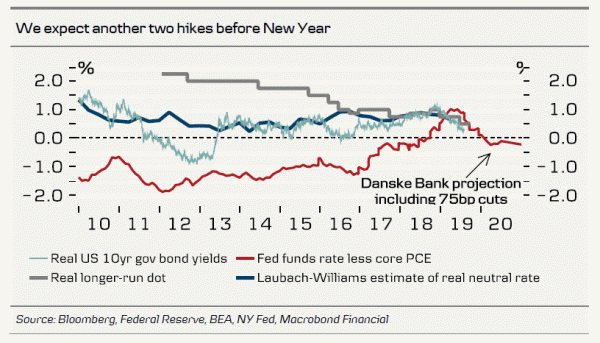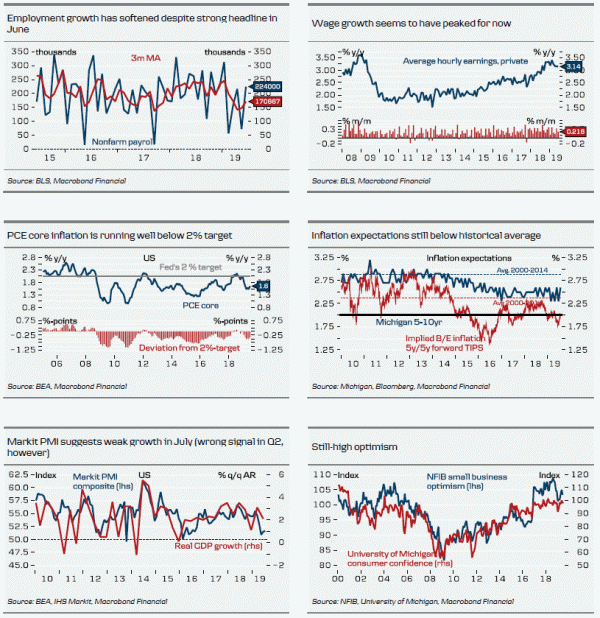Fed outlook: more cuts depend on data and trade talks
As expected, the Federal Reserve cut its Fed funds target range by 25bp to the range 2.00-2.25% (8-2 vote in favour). A bit surprisingly, the Fed also decided to end its balance sheet reduction from today, a couple of months earlier than scheduled, but the decision is not a game changer. Based on the statement and press conference, there are mainly three reasons for easing: (1) higher (trade) uncertainty, (2) slower global growth and (3) inflation remains below 2%.
As it was one of meetings without updated dots, focus was on the statement and the press conference. In line with our expectation, the Fed repeated in the statement that it ‘will act as appropriate to sustain the expansion’, which we interpret as an easing bias suggesting more cuts may come. However, it is also clear that Powell & co will not pre-commit to more cuts, which left markets disappointed and was slightly to the hawkish side also for us. Powell did not rule out more cuts at the press conference but in his base case he does not see the cut as the beginning of a long easing cycle but rather a mid-cycle adjustment (or insurance cut). Whether more will come will depend on data and the trade talks.
In our view, the Fed is still set to deliver two more cuts during the autumn (in September and December), as data would probably warrant it and the Fed does not want to disappoint markets too much . Given the Fed’s data dependency and focus on trade talks, it has become more difficult to predict monetary policy, which is more ad hoc than previously. Despite the US expansion now being the longest on record, the solid Q2 GDP growth and the low unemployment rate, we stick to our view that the benefits of easing monetary policy are now slightly greater than the costs of not easing monetary policy. Inflation remains on the low side and the uncertainty surrounding the macro outlook has increased.
FI: the 2s10s curve flattens as Powell disappoints the market
The reaction to ‘only’ 25bp and not least the Powell comment that this is not the, ‘beginning of a long easing cycle’ was a significant flattening of the 2s10s curve. 2y yields initially moved higher as the market lowered the probability of further rate cuts, whereas 10Y yields moved lower in a kind of bearish flattening move. Financial markets are concerned that the Fed is not ready to deliver the needed rate cuts or give the needed guidance to keep risk appetite and inflation appetite in check.
We still look for two more rate cuts in 2019, but the market might for now be reluctant to price in aggressive easing or a ‘long series of rate cuts’. However, given the global weakness and record low long yields in Europe we continue to see downside for 10Y US treasury yields, as the more ‘cautious’ Powell approach will not support market inflation expectations but will support a further flattening of the curve. It seems that the usual steepening of the 2s10s curve after the ‘first rate cut’ has been postponed for now . We keep our three to six months’ 1.75% target for 10Y US treasury yields unchanged.
FX: tactical case for weaker USD suffers blow
In FX the broad USD rallied on markets pricing out rate cut probability mass in the front end of the curve. Consequently, EUR/USD set two-year lows below 1.1100. Our view has for some time been that, although both the Fed and the ECB have turned into easing mode, it is primarily rate cuts that matter for FX and hence EUR/USD. In that light our call for a weaker broad USD has suffered a blow, as we expected more commitment to easing from the Fed.
We would not be surprised to see USD strength persist further into August as high carry/low FX vol make long USD FX attractive from a broader portfolio perspective. Indeed, we would probably need a significant (and unlikely) short-term deterioration in US data, a complete breakdown in US-China trade talks and/or a hefty equity sell-off for the USD to lose recent gains in the coming weeks. More persistent USD strength than we expected also marks a headwind for commodity currencies in AUD, NZD, CAD, NOK and high beta currencies like SEK that tend to suffer in strengthening dollar/risk off environments.
We are in the process of revising our FX forecasts and plan to send out a new update next week. For now we close our short USD basket, see FX Trading Portfolio – Short USD vs equal-weighted basket (CHF, NOK, MXN), 20 June, with a loss of 1.9% as we think the tactical case of being short USD is gone.
That said, strategically we still see a case for a weaker USD this autumn. With our expectation of (1) additional two Fed rate cuts this year, (2) a rebound in global data in H2 on the back of easier financial conditions combined with (3) a potential trade deal, this would all support an environment where EUR/USD should rise and the broad USD weaken. For now, however, we think it is too early to position for a setback in the greenback.















